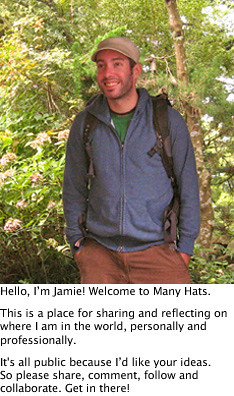Remixing the Remix
In 2003 I moved to Taiwan and went out looking for somewhere to dance. The problem was, everyplace I walked into was blowing out the most horrific Asian techno (which really was a genre at that point), and I would be perpetually frustrated by my attempts. So, I became a DJ… One clear way to ensure that someone would be playing music I’d want to dance to.
In this newly adopted role I began to devote a large amount of time to researching music, and came across the mash-up pioneers of the era, like DJ Z-trip, and 2 Many DJs. I’ve always loved hearing musicians cover each others songs, paying tribute to the creators while embracing the freedom to make the music their own. These mash-up artists approached it with different tools, but it was the same ethic. Producers were doing things like taking instrumental tracks from one song and vocals from another, then marrying them in exciting and surprising new ways. There were these incredible synergistic moments where two pieces I loved previously came together in a way I’d never imagined, and eye-opening creations where things I may not have been so keen on were elevated by their re-contextualization. Take this example of a mash-up of Missy Elliot (who I’d enjoyed for a while) and George Michael (who I’d never had much time for). After listening to them together, I came to feel that maybe there was more to George than I’d given him credit for previously.
Recently, watching Lawrence Lessig’s TED talk “Re-examing the remix” I reflected on his insights on this media phenomenon. Towards the end of the talk Lessig poses the question: “How do we build an ecology of freedom?” by which he means an artistic media culture in which the values of freedom, community, limited regulation and respect for creators are nurtured, and legislation and copyright stringency do not smother creative freedom.
I’ve long since stopped DJing parties, but my personal connections to these questions have been born again in the form of an album released last year by my brother Josh under the pseudonym Kids & Explosions. I’m pretty sure there isn’t an “original” note of music on the album, in the sense that I believe every sound is sampled from previous recordings. My brother and I have very similar taste in music, and putting the album on for the first time made me feel like this was a record that had been made just for me. An album of a thousand samples, 900 of which I could just about identify, re-imagined as a series of gorgeously fun, complex and oddly catchy tunes. First and foremost, I think this album is one of creative musical inspiration, but it is clearly also a tribute to the musicians sampled throughout.
Hands down, this was my favorite album last year and consequently, I played it a lot. When people first heard the album, right after either professing their love of it, or looking oddly pained, they would often ask me how he got away with using other people’s music.
In this interview on CBC Radio, at about the 3 minute mark, Josh talks for a bit about his remixing the sounds of other musicians, and how he understands that process as fitting into a sort of history of musical production. Basically, he explains that the reason he gets questioned about his use of existing music all the time is not because what he does is unique. His reworking of material is not a rare thing. He believes he is questioned about it primarily because so much of the music he reworks is well known. There’s a long history, he explains, of hip hop musicians, among others, digging through record crates to come up with amazing old Soul samples and the like, but when they’re used, very few people recognize the sources. What he goes on to say is that the reason he uses such well known material is that he wants to make music from music he loves. That’s what makes it meaningful to him.
I think that is probably the key consideration when we think about the ethics of remixing. The enormous majority of remixes come with a deep dose of tribute and affection. To be sure there are satirical remixes out there, but they’re a whole other discussion. Most of the remixes that flood YouTube and other channels are without any doubt deeply respectful of the creators they borrow from.
While searching for an old interview clip for this post, I came across something that made me smile. This remix album of my brother’s has now been remixed, and remixed, and remixed, and remixed. I quickly came across several examples of this including raps over his music and an animated sequence of some Biggie Smalls lyrics, from my brother’s track: There is a Burning Ball of Fire in Outer Space.
Scrolling down, after watching the animated typography remix, I came across something amazing. What followed on the page was a discussion amongst the poster and commenters about the exact copyright issues that Lawrence Lessig was discussing in his TED talk, clear examples of how muddy the roads of copyright and remixing have become. But something else stood out for me too. The very first post by the typographic animator included a direct tribute to Kids & Explosions, along with a link and a suggestion that viewers purchase the original album. If we needed a crystal clear example of the respect held for creators by remixers, this must be it.
My sense is that remix culture has profoundly deep roots of the type Lessig discusses. It is very much about freedom to use artistic material, a community that shares and inspires, limited regulation or restriction of creativity, and profound respect for the creators at every stage and manifestation of the game. The challenge it faces, I suppose, is that the same fear and response which media producers have applied to the worlds of file-sharing, the direct re-distribution of copy written materials, has also been applied at times to the world of remixes, which are clearly another beast altogether.
Related
7 Responses to Remixing the Remix
Leave a Reply Cancel reply
This site uses Akismet to reduce spam. Learn how your comment data is processed.
MY CLASS BLOG
This is my classy, yet personal blog. For my less personal –but perhaps classier– classroom blogs, click here, or here.MANY HATS in your inbox
Subscribe to Many Hats...

many hats by Jamie Raskin is licensed under a Creative Commons Attribution-NonCommercial-ShareAlike 3.0 Unported License.Details… details…
CATEGORIES
@jamieraskin
My TweetsINVASION PROGRESS




















































HISTORY
MANY COMMENTS












Another great post! It reminds me of this the movie:
‘Good Copy Bad Copy’
http://www.youtube.com/watch?v=Ez1rYlVoges
Have you seen it? In the documentary Girl Talk, the producer and DJ is remixes “a Brazilian remix of an American song”.
Cheers Mitch-
I realized you came late and I left late on Tuesday, so I didn’t even get a chance to say hi. Lets touch base on Saturday. Thanks for the comment. I just watched the first 5 minutes of the Girl Talk bio. I’m gonna pre-load it and watch it on the train! Cheers for that.
jamie
Thanks for this; I thoroughly enjoyed reading (and listening to) your post. While you focused on music, I’ve been thinking about different art forms. There are always arguments which emerge about originality, but the ultimately it seems to be about distinguishing between a clear cut imitation and a creative retelling, reinterpretation, reworking, remix…
Artists I thought of: Shakespeare (collaborator, borrower, transformer…)
Also, check out the case of UK artist and Turner Prize nominee Glenn Brown, whose painting caused considerable debate in the year 2000: http://news.bbc.co.uk/2/hi/entertainment/1044375.stm …and this reflective article on a 2009 exhibition of his ‘second-hand’ art: http://ind.pn/tdI0Ul Worth reading for some of the descriptions of his art, where it’s “as if El Greco had listened to Joy Division” and instead of simply copying, he “distorts and manipulates”.
Hey Madeleine,
Thanks for the comment! I think you’re right. We tend to focus on the digital manifestations of remixing, borrowing and what not, probably for a few reasons. One, I guess it’s easier to track that its predecessors were. Digital data has a pretty searchable fingerprint. Also, the tools to enable these practices have proliferated in their use and availability so widely, it’s less and less a fringe element of creative production. When remixing becomes mainstream, it rubs up uncomfortably against other creative forms. I’ll have a look at the story you suggested! Hope your holidays are going great!
Cheers, J.
Well Jamie,
Little did I know you had a DJ past. In some respects, I suppose, I should have suspected it. As often, I am impressed by your eloquent writing style. You tell a good tale. I was surprised by the speed with which your brother was able to make such a splash. Aahhh… The power of the internet.
On the other hand, however, long have I pondered the disparity between the the new tools available to create and the amount of masterful creation we see in the contemporary world. I mean, we have made such incredible technological advances and yet, to my limited awareness at least, there hasn’t been a Mozart in my lifetime. (Though while writing this I feel certain this must not be true by broader definitions.) The remix, while certainly not reaching this level of originality and masterful creation, is definitely an outlet that will lead to ever-greater potential creativity. Have I read how it is the 21st century’s “new folk art” or is it possibly a phrase of some originality? I suppose since, Everything is a Remix, it may not really matter. An enjoyable read, at any rate.
Despite meeting with you regularly here I sit on the train learning more personal details of where you have lived and what you have done. Which raises another, perhaps overly optimistic thought. I know you share some of the same concerns having discussed it with you before but, as a nature lover, I have long feared a digital future in which children spend too much time with gadgets and not enough outdoors living authentically as they should, in nature, with (or without) other people. My studies for the COETAIL program have dispelled some of these fears greatly and brought so much more together for me both professionally and personally.
The emerging digital age does not necessarily mean fragmentation and disassociation from others. It may be exactly the opposite. It brings children together in collaboration. Everyone knows something others do not. The fact that students can share with other children the world over adds a whole new dimension to their possible collaborations. I believe I need to speak with Clair for grounding.
Thanks for the comment Sean!
I think it’s interesting, as you said, to consider that rather than looking at the digital age as a cause of fragmentation and disassociation of social interactions, we may be seeing the opening of what are really just other modes of genuine social interaction. It’s all clearly about balance isn’t it. Definitely refining these interactions is a major reason I’m enjoying the content and processes of these studies. Happy holidays! See you in January. -J
The idea of a remix of a remix of a remix might make my head explode, but it raises the right questions around what’s okay and what’s too much. And there really isn’t a right answer to this question.